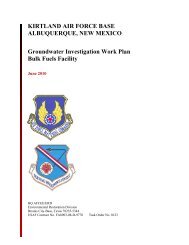Final FONSI and EA for hot cargo pad on Kirtland AFB - Kirtland Air ...
Final FONSI and EA for hot cargo pad on Kirtland AFB - Kirtland Air ...
Final FONSI and EA for hot cargo pad on Kirtland AFB - Kirtland Air ...
You also want an ePaper? Increase the reach of your titles
YUMPU automatically turns print PDFs into web optimized ePapers that Google loves.
<str<strong>on</strong>g>Final</str<strong>on</strong>g> <str<strong>on</strong>g>EA</str<strong>on</strong>g> Addressing C<strong>on</strong>structi<strong>on</strong>, Operati<strong>on</strong>, <str<strong>on</strong>g>and</str<strong>on</strong>g> Maintenance of a Hot Cargo Pad<br />
Source: USAF 1996<br />
Figure 3-9. Hot Cargo Pad Design Criteria<br />
Risk is the probability <str<strong>on</strong>g>and</str<strong>on</strong>g> severity of loss from exposure to a hazard, such as the loading of weap<strong>on</strong>s,<br />
ammuniti<strong>on</strong>, explosives, <str<strong>on</strong>g>and</str<strong>on</strong>g> other hazardous <str<strong>on</strong>g>cargo</str<strong>on</strong>g> from various aircraft. The assessment step is the<br />
applicati<strong>on</strong> of quantitative or qualitative measures to determine the level of risk associated with a specific<br />
hazard. This process defines the probability <str<strong>on</strong>g>and</str<strong>on</strong>g> severity of a mishap that could result from the hazard<br />
based up<strong>on</strong> the exposure of pers<strong>on</strong>nel or assets to that hazard (USAF 2009).<br />
Historical mishap databases enable the military to calculate the mishap rates <str<strong>on</strong>g>for</str<strong>on</strong>g> each type of aircraft.<br />
These rates are based <strong>on</strong> the estimated flying time that an aircraft is expected to be in the airspace, the<br />
accident rate per 100,000 flying hours <str<strong>on</strong>g>for</str<strong>on</strong>g> that aircraft, <str<strong>on</strong>g>and</str<strong>on</strong>g> the annual flying hours <str<strong>on</strong>g>for</str<strong>on</strong>g> that aircraft. Since<br />
the incepti<strong>on</strong> of the USAF in 1947, aircraft accidents have steadily declined each year.<br />
Because of the potentially damaging effects of explosives mishaps, separate facilities, such as a <str<strong>on</strong>g>hot</str<strong>on</strong>g> <str<strong>on</strong>g>cargo</str<strong>on</strong>g><br />
<str<strong>on</strong>g>pad</str<strong>on</strong>g> (which is separate from the existing apr<strong>on</strong>) are provided <str<strong>on</strong>g>for</str<strong>on</strong>g> explosives operati<strong>on</strong>s based <strong>on</strong> the type<br />
of hazards involved (USAF 1996). Weap<strong>on</strong> systems such as guns, rockets, missiles, <str<strong>on</strong>g>and</str<strong>on</strong>g> flare dispensers<br />
pose an additi<strong>on</strong>al hazard because of their directi<strong>on</strong>al resp<strong>on</strong>se <str<strong>on</strong>g>and</str<strong>on</strong>g> potential l<strong>on</strong>g range if inadvertently<br />
activated <strong>on</strong> the ground. <strong>Air</strong>craft are positi<strong>on</strong>ed to present the minimum hazard to pers<strong>on</strong>nel <str<strong>on</strong>g>and</str<strong>on</strong>g><br />
resources in the event of a mishap (USAF 2009).<br />
Per AFH 32-1084, a <str<strong>on</strong>g>hot</str<strong>on</strong>g> <str<strong>on</strong>g>cargo</str<strong>on</strong>g> <str<strong>on</strong>g>pad</str<strong>on</strong>g> is required at installati<strong>on</strong>s where explosives or other dangerous<br />
materials must be loaded frequently <strong>on</strong> <str<strong>on</strong>g>cargo</str<strong>on</strong>g> aircraft <str<strong>on</strong>g>and</str<strong>on</strong>g> where existing apr<strong>on</strong>s cannot be used without<br />
violating QD safety criteria. The term QD refers to protecti<strong>on</strong> requirements from PESs to different kinds<br />
of ESs. The QD st<str<strong>on</strong>g>and</str<strong>on</strong>g>ards were developed over many years <str<strong>on</strong>g>and</str<strong>on</strong>g> are based <strong>on</strong> explosives mishaps <str<strong>on</strong>g>and</str<strong>on</strong>g><br />
tests. As discussed in Secti<strong>on</strong> 2.1.2, an IB separati<strong>on</strong> distance of 1,250 feet (approximately 0.24 miles) is<br />
required <str<strong>on</strong>g>for</str<strong>on</strong>g> Hazard Classificati<strong>on</strong> 1.1 explosives. At this distance some damage could still be expected<br />
Kirtl<str<strong>on</strong>g>and</str<strong>on</strong>g> <strong>AFB</strong>, NM January 2011<br />
3-39
















